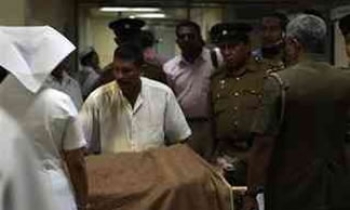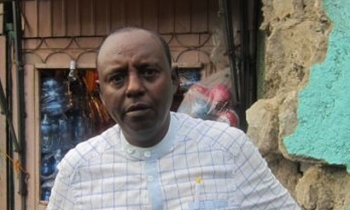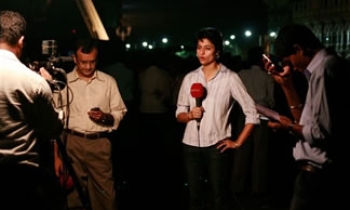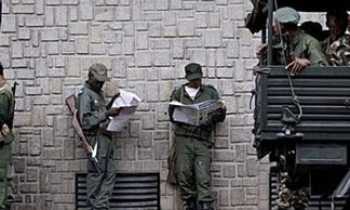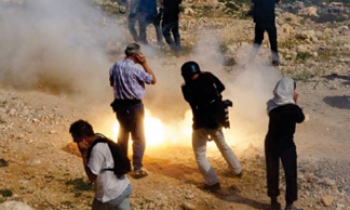I cringed, along with everyone else, when I saw The Post's above-the-fold headline yesterday: "12 Found Alive in W. Va. Coal Mine."
And USA Today's banner: "'Alive!' Miners Beat the Odds." And the Atlanta Journal Constitution: "12 Miners Alive." And Newsday: "Miracle in the Mine."
If there's been a more heart-rending and humiliating botch of a story, I can't think of it offhand. Yes, the Chicago Tribune elected Dewey in '48 and the networks practically elected Gore in '00, but here there were loved ones desperately awaiting word on the miners, whose premature euphoria was dashed. Cable news was celebratory until CNN's Anderson Cooper broke the story at 2:47 a.m. that all but one miner was dead, not alive.
Sure, the bum information came from West Virginia's governor, and the coal company shamefully refused to correct the record for hours. But the fault lies with the journalists for not instinctively understanding that early, fragmentary information in times of crisis is often wrong. You don't broadcast or publish until it's absolutely nailed down, or at least you hedge the report six ways to Sunday. This was, quite simply, a media debacle, born of news organizations' feverish need to breathlessly report each development 30 seconds ahead of their competitors.
But do journalists blame themselves? Many, you will not be shocked to hear, don't. Here's Associated Press Managing Editor Mike Silverman: ""AP was reporting accurately the information that we were provided by credible sources -- family members and the governor. Clearly, as time passed and there was no firsthand evidence the miners were alive, the best information would have come from mine company officials, but they chose not to talk."
But the "credible sources" didn't know what they were talking about, and the reporters didn't press them hard enough. Remember that another credible source, New Orleans Mayor Ray Nagin, said all sorts of things about violence and so on in the aftermath of Katrina that turned out not to be true. Just quoting someone who's giving you bum information doesn't let you off the hook.
Now a case could be made that we've overcovered this story, that the fate of a dozen miners, as tragic as it is, was not of the same national importance as, say, Jack Abramoff flipping in a case that could implicate a dozen congressmen in corruption. But it was a compelling human drama, the kind that television in particular thrives on.
Still, let's face it: How much have the media done on mine safety in the last few years? Has anyone (I'm sure there are a few exceptions) looked at coal company violations, or how the Bush administration is or isn't enforcing the law? Probably about the same number of journalists who did pieces on why a former Arabian horse official was running FEMA's dysfunctional bureaucracy.
The Sago Mine, we learn now, had 273 safety violations in the past two years, 16 of them very serious. You will now be buried (forgive me) by stories about mine safety, just as you were flooded by post-Katrina pieces on FEMA's problems. But why do the media only get serious about health, safety and regulatory agencies after a major disaster? Heck of a job.
"Are the watchdogs doing their jobs?" NBC's Brian Williams asked last night. I'd extend that question to the press.
"How," asks the Los Angeles Times, "could the media -- mostly morning newspapers, since radio, television and the Internet could instantaneously correct their errors -- get it so wrong?
"It was, said editors across the country, a matter of meeting deadlines and relying on sources that seemed credible, including West Virginia Gov. Joe Manchin, a congressman and family members of the miners, who gave reporters news of the miners' apparent survival about midnight Eastern time, three hours before the deaths became known."
CJR's Gal Beckerman delivers a scolding: "Maybe the reporters on the ground in West Virginia were just plain tired. Or maybe they themselves were swept up in the euphoria and wanted to believe. Otherwise, it's hard to explain how the erroneous news of the survival and rescue of 12 of the 13 miners caught underneath the ground in Sago, West Virginia made it to the front pages of our nation's papers.
"A close reading of the articles themselves tells the tale of how journalists bungled the story: In most, there are no sources at all for the information; in some, the sources are the rumors spread by frantic family members. Those sorts of sources are hardly a solid basis for headlines screaming, 'They're Alive!'
"Take a look at how the venerable Washington Post began its story: 'A dozen miners trapped 12,000 feet into a mountainside since early Monday were found alive Tuesday night just hours after rescuers found the body of a 13th man, who died in an explosion in an adjacent coal mine that was sealed off in early December.'...
"All untrue -- but written with stunning confidence. Nowhere in this Post piece is there any mention of sources."
Kudos to Wichita Eagle Editor Sherry Chisenhall for explaining yesterday why "we (and newspapers across the country) went to press last night with the information we had at the time. But it won't excuse the blunt truth that we violated a basic tenet of journalism today in our printed edition: Report what you know and how you know it. . . .
"Many newspapers and TV stations reported exactly what we did today. But being wrong in crowded company is still being wrong. Our commitment to our readers is to tell you exactly what we know and how we know it. Today, we fell short."
Vaughn Ververs of CBS's Public Eye blog says: "The media doesn't need any apologists, and that's not the aim here. Certainly news organizations could have been much more cautious in what they were reporting and distinguishing between what had actually been confirmed and what had not. The New York Times may have handled it the best with its morning headline, which read: '12 Miners Are Found Alive, Family Members Say.' The story, written by James Dao, sourced the story to 'family members and a state official.'
"But to say that the massive failing here rests on the shoulders of the media alone is almost as misleading as the information that was spread between midnight and 3:00am this morning."
Jeff Jarvis, on the other hand, is disgusted:
"One terrible lesson of the West Virginia mine tragedy is that you can't trust the news. You never could; it has always taken time to see whether stories pan out, to get all the facts, to find out the truth. But now, in our age of instant news and ubiquitous communication, the public sees this process as it occurs. It's not the news that's live; it's the process of figuring out what to believe that's live. Now, indeed, everyone is a reporter and an editor and the public is learning, as reporters learned, that they need to find their ways through the fog of news. The next time I hear someone being haughty about professional news vs. citizen's news, I'll remind them of the West Virginia tragedy, where news traveled ahead of the facts, where everyone was horribly wrong."
At the Huffington Post, Marty Kaplan is in the too-much-coverage camp:
"It's painful to watch television news producers try to figure out the relative importance of the unfolding stories of the 13 trapped miners in West Virginia, and the more than 13 trapped Congressmen in Washington.

